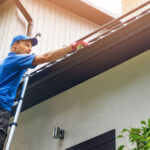Snow has finally arrived. During this part of the year, it is particularly important to protect your home from water damage. Not only is it imperative to redirect water from gutter downspouts away from the house, but it is also very important to keep those gutters and downspouts from freezing all winter long.
Frozen gutters prevent water from properly draining moisture from the roof and resulting in a cascading over the side that may in turn make for slippery ground around the home. So not only is it important to your home, but also it is a safety measure to keep you and others from slipping on the ice.
There are several ways to keep your gutters from freezing. If your roof has only a slight slope, you might consider removing the snow by hand as it accumulates on the roof. While flatter roofs are generally more prone to water damage, this is a smart idea in any case. Make sure that, at all times, you are secured with a safety strap to prevent falling off of the roof. Better yet, it might be wise to hire a licensed and bonded contractor to do this for you. Particularly in mountain areas, there are plenty of companies offering this kind of service at reasonable prices.
The material of the roof also plays some role in how quickly the ice will melt. While “rolled-on” roofs and composite shingles take much longer for the ice to melt, metal roofs and, in particular, copper roofs will absorb any sunlight much more efficiently and hence melt the snow and ice more quickly.
The simpler route would be to install an ice melting option at the edge of the roof that extends into the gutters and downspouts. Once turned on, the warmed tape, cable or edge will keep any moisture accumulation from freezing. Here are some options:
- Edge heaters. These are strips of metal that are placed at the bottom of the roof line just before it hits the gutters. The advantage is that the roof will not have to be penetrated for installation. The downside is that this method only keeps the ice and snow off the very edge.
- Zig-zag cables. These are strings of cable that heat up and are laid in a zig-zag fashion at the edge of the roof. This is the most cost-effective of the heating solutions, but will require clipping or nailing onto the roof.
- Radiant Roof Mats. In this case, the mats are laid on the roof BEFORE the final roofing material. This option is not only the most effective de-icing solution, but also it is the most expensive and can only be done during construction.
To minimize operating costs, all systems should be connected to a thermal or moisture sensor switch that would operate the heat only when certain temperatures are met or the moisture level rises. Also, it should not be overlooked that any heated option should operate ONLY on a roof and in gutters free of any debris such as fallen leaves to prevent possible fires.
Finally, and although this may seem obvious, don’t forget to make sure that the downspouts direct the water away from the home and away from any walk or drive paths.
Talk to a professional contractor to determine what option might be best for you, or feel free to call me anytime with additional questions or concerns.



